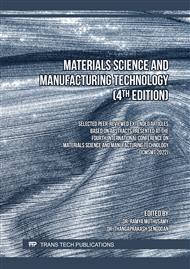[1]
N. Deshpande and H. Vasudevan, Machining Induced Surface Integrity Aspects of Stainless Steels: A Review,, Mater. Today Proc., vol. 22, p.1499–1506, (2020).
DOI: 10.1016/j.matpr.2020.02.067
Google Scholar
[2]
E. Capello, Residual stresses in turning Part I: Influence of Process Parameters,, J. Mater. Process. Technol., vol. 160, no. 2, p.221–228, Mar. (2005).
Google Scholar
[3]
J. D. Thiele, S. N. Melkote, R. A. Peascoe, and T. R. Watkins, Effect of Cutting-Edge Geometry and Workpiece Hardness on Surface Residual Stresses in Finish Hard Turning of AISI 52100,, vol. 122, no. November, p.642–649, (2000).
DOI: 10.1115/1.1286369
Google Scholar
[4]
D. Y. Jang, J. Liou, and U. Cho, Study of Residual Stress Distribution in the Machined Stainless Steel Components,, Tribol. Trans., vol. 37, no. 3, p.594–600, (1994).
DOI: 10.1080/10402009408983334
Google Scholar
[5]
D. Y. Jang, T. R. Watkins, K. J. Kozaczek, C. R. Hubbard, and O. B. Cavin, Surface residual stresses in machined austenitic stainless steel,, Wear, vol. 194, no. 1–2, p.168–173, (1996).
DOI: 10.1016/0043-1648(95)06838-4
Google Scholar
[6]
J. Rajaguru and N. Arunachalam, Coated tool Performance in Dry Turning of Super Duplex Stainless Steel,, Procedia Manuf., vol. 10, p.601–611, (2017).
DOI: 10.1016/j.promfg.2017.07.061
Google Scholar
[7]
X. Da Huang, X. M. Zhang, and H. Ding, A novel relaxation-free analytical method for prediction of residual stress induced by mechanical load during orthogonal machining,, Int. J. Mech. Sci., vol. 115–116, p.299–309, (2016).
DOI: 10.1016/j.ijmecsci.2016.06.024
Google Scholar
[8]
M. H. El-Axir, A method of modeling residual stress distribution in turning for different materials,, Int. J. Mach. Tools Manuf., vol. 42, no. 9, p.1055–1063, Jul. (2002).
DOI: 10.1016/s0890-6955(02)00031-7
Google Scholar
[9]
S. Mittal and C. R. Liu, A method of modeling residual stresses in superfinish hard turning,, Wear, vol. 218, p.21–33, (1998).
DOI: 10.1016/s0043-1648(98)00201-4
Google Scholar
[10]
B. Jones and C. J. Nachtsheim, A class of three-level designs for definitive screening in the presence of second-order effects,, J. Qual. Technol., vol. 43, no. 1, p.1–15, (2011).
DOI: 10.1080/00224065.2011.11917841
Google Scholar
[11]
B. Jones and C. J. Nachtsheim, Definitive screening designs with added two-level categorical factors,, J. Qual. Technol., vol. 45, no. 2, p.121–129, (2013).
DOI: 10.1080/00224065.2013.11917921
Google Scholar
[12]
O. A. Mohamed, S. H. Masood, and J. L. Bhowmik, Experimental investigation of creep deformation of part processed by fused deposition modeling using definitive screening design,, Addit. Manuf., vol. 18, p.164–170, Dec. (2017).
DOI: 10.1016/j.addma.2017.10.013
Google Scholar
[13]
Y. Yan, R. Helmons, C. Wheeler, and D. Schott, Optimization of a convex pattern surface for sliding wear reduction based on a definitive screening design and discrete element method,, Powder Technol., vol. 394, p.1094–1110, Dec. (2021).
DOI: 10.1016/j.powtec.2021.09.041
Google Scholar
[14]
I. Alvarez-Armas and S. Degallaix-Moreuil, Duplex stainless steels. London; Hoboken, NJ: ISTE ; J. Wiley, (2009).
DOI: 10.1002/9781118557990
Google Scholar



